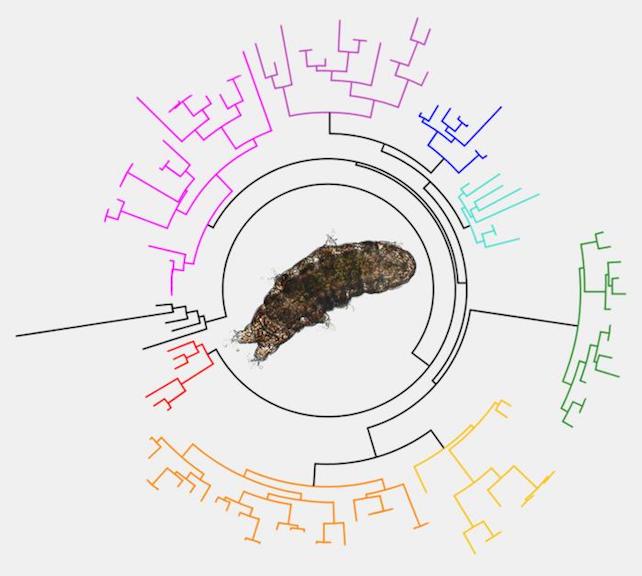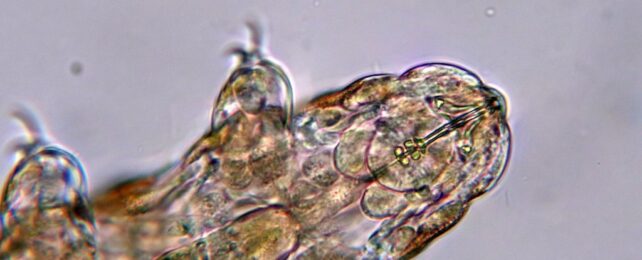Tardigrades stand apart from much of the animal kingdom due to their extreme durability, which famously helps the tiny creatures survive being boiled, frozen, irradiated, and fired from a gun, among other indignities.
Hoping to better understand these superpowers, scientists have identified many individual genes that may contribute to tardigrades' survival skills. Less clear, however, is the bigger picture: Where, how, and why did all these amazing adaptations evolve?
In a new study, researchers shed a little more light on this surprisingly complex history, suggesting ancient tardigrades made the transition from marine to terrestrial environments twice, followed by "numerous independent adaptations to cope with aridity" on land.
Today, tardigrades exist all over the planet, thriving in a wide range of environments at sea and on land, from deep ocean mud and Antarctic rocks to mountains, rainforests, and gardens.
Also known as 'water bears' and 'moss piglets,' tardigrades have become renowned as some of the most resilient animals known to science, even demonstrating an ability to survive in the vacuum of space.
Key to many of their feats of survival is anhydrobiosis, a dormant state in which tardigrades can reversibly halt their metabolism, helping them withstand almost complete desiccation.
Previous research has identified multiple gene families that are unique to tardigrades and show an association with extreme metabolic shutdown in response to lack of water, known as anhydrobiosis, including several related to heat-soluble proteins, along with some stress-resistance genes that also exist in other animals.
Despite those insights, however, research has so far yielded little data from most tardigrade lineages, according to the authors of the new study, leaving major gaps in our knowledge about tardigrade evolution and ecology.
To address that, the authors identified sequences from six gene families across 13 genera of tardigrades, including members of both of the two major classes – eutardigrades and heterotardigrades — letting researchers build the first evolutionary trees for these tardigrade groups.
Since anhydrobiosis presumably would be more useful to terrestrial tardigrades than to their ocean-dwelling relatives, researchers expected to find a connection between gene duplications in these families and habitat changes among tardigrades.
"When we began the work, we expected to find that each clade would be clearly grouped around ancient duplications, with few independent losses," Keio University bioscientist James Fleming told Indiana University biologist Casey McGrath in a commentary on the paper. "That would help us easily tie them to an understanding of modern habitats and ecology."

"It's an intuitive hypothesis," Fleming adds, "that the evolution of the duplications of these desiccation-related genes should, in theory, contain remnants of the ecological history of these organisms, although, in reality, this turned out to be overly simplistic."
Fleming and his colleagues say they were surprised by how many independent duplications they found in these gene families, suggesting the evolution of genes related to anhydrobiosis was significantly more complicated than previously thought.
"What we found was far more exciting: a complex network of independent gains and losses that does not necessarily correlate to modern terrestrial species ecologies," Fleming says.
Based on the distribution of gene families across the two major tardigrade classes, the researchers believe there were two separate transitions from marine to terrestrial habitats in tardigrades' history, once in the ancestor of eutardigrades and once among heterotardigrades.
While this study helps advance our knowledge about the history of anhydrobiosis in tardigrades, there is still a lot we don't understand, the researchers say. Clarity is lacking partly due to meager or nonexistent data from some key tardigrade lineages, they add.
"We unfortunately have no representatives from several important families, such as the Isohypsibiidae, and this does limit how firmly we can stand by our conclusions," Fleming says. "With more freshwater and marine tardigrade samples, we will be better able to appreciate the adaptations of terrestrial members of the group."
That's easier said than done, however, especially given the difficulty in tracking down types of tardigrades. Tanarctus bubulubus, for example, is too small to see without magnification and lives only in mud deep beneath the North Atlantic Ocean.
"Hopefully, large-scale sequencing initiatives through the Earth Biogenome Project will steadily bridge this gap in our understanding, and it's an effort I'm excited to see continue," Fleming says.
The study was published in Genome Biology and Evolution.
